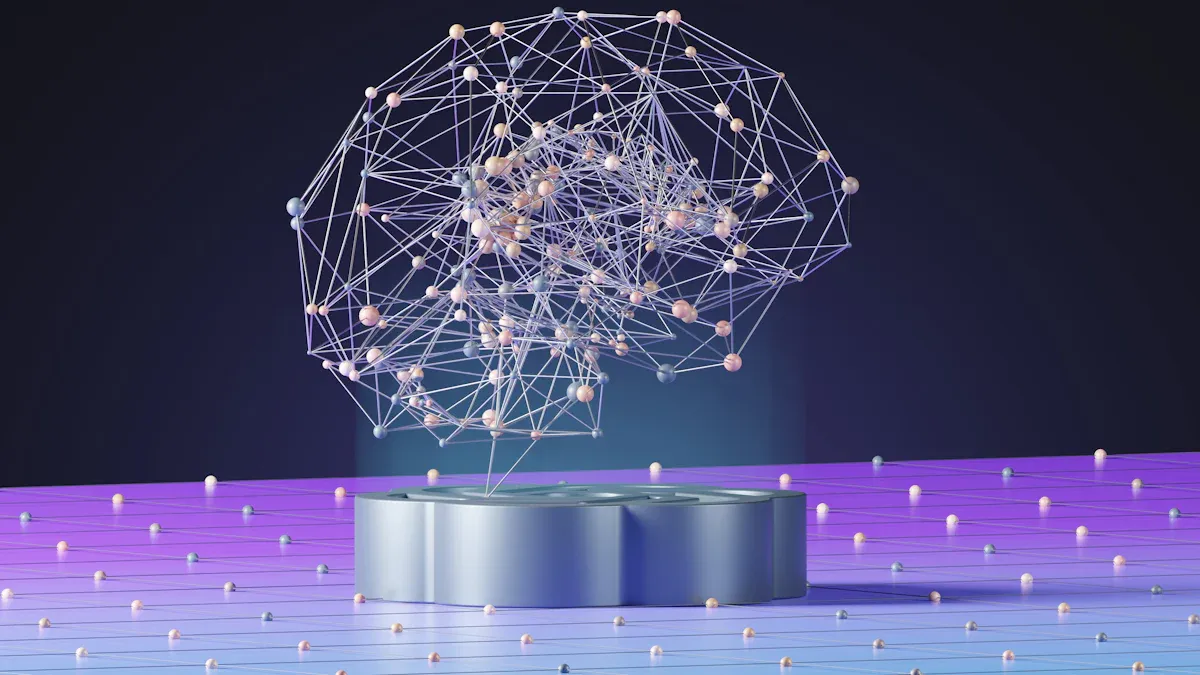Oracle Meaning in the Age of AI and Modern Data Tools

The oracle meaning in technology has shifted dramatically over decades.
In the late 1970s, oracle described a pioneering SQL-based database system that set industry standards for data management.
Over time, oracle evolved into a symbol of enterprise-grade technology, expanding into cloud services, integrated hardware, and automated tools.
Today, as AI and new data tools emerge, understanding this transformation becomes crucial. When legacy databases meet platforms like Chat2DB or Oracle Cloud Infrastructure, clarity in terminology ensures teams harness the full power of modern technology.
Key Takeaways
Oracle started as a pioneering database system and evolved into a symbol of enterprise-grade technology with cloud and AI integration.
Modern oracles embed AI to automate data management, improve security, and deliver real-time insights, reducing manual work and speeding decisions.
Platforms like Chat2DB make data access easy and secure by allowing natural language queries and local data processing across many databases.
Oracle Cloud Infrastructure supports smooth migration from legacy systems, offering tools for real-time analytics, automation, and strong security.
The future of oracles lies in AI-powered, integrated solutions that boost efficiency, trust, and flexibility for businesses of all sizes.
Oracle Meaning in Legacy Tech

Databases and Centralized Truth
In the early days of enterprise technology, the oracle meaning centered on the idea of a single, authoritative source of data. Legacy systems relied on centralized databases to store business logic, user information, and application data. Oracle applications such as Oracle Forms and Oracle APEX tightly coupled their business processes with the Oracle Database. This approach allowed organizations to manage data, security, and user interfaces from one place. The Oracle Internet Directory extended this concept by providing LDAP-compliant directory services, enabling centralized management of user identities and access permissions across enterprise networks.
Centralized data management brought consistency and reliability to business operations. However, it also created challenges when organizations needed to modernize or scale their systems. Legacy Oracle applications often contained decades of accumulated business logic, making direct migration to new platforms difficult. As a result, the oracle meaning in legacy environments became synonymous with a database-driven, integrated platform that served as the backbone for enterprise data and identity management.
Oracle Corporation’s Role
Oracle Corporation played a pivotal role in shaping the evolution of database technology and the broader enterprise landscape. Founded by Bob Miner, Larry Ellison, and Ed Oates, Oracle introduced the first commercially available relational database management system using SQL in 1979. The company quickly expanded its reach by supporting multiple computing platforms and developing a single code base for its products. Oracle’s innovations included distributed databases, client/server architecture, and advanced features like cost-based optimizers and parallel operations.
Throughout its history, Oracle adapted to changing business needs by integrating new technologies such as Java Virtual Machine and grid computing. Strategic acquisitions, including Sun Microsystems and PeopleSoft, further strengthened its position in enterprise software and cloud services. Oracle’s commitment to simplification, standardization, and automation made its technology a strategic asset for businesses worldwide. The company’s ongoing influence continues to define the oracle meaning for organizations relying on robust, scalable data solutions.
Evolution of Oracle Meaning
From Legacy to AI
The oracle meaning has transformed as artificial intelligence and machine learning have become central to modern data management. In the past, oracle described a database system focused on storing and retrieving information. Today, Oracle Database 23ai represents a new era by embedding AI directly into its core. This shift allows organizations to use AI-powered analytics, automation, and security without relying on external tools.
Oracle Database 23ai introduces features like AI Vector Search, which enables semantic searches on unstructured data. Users can now retrieve information more efficiently and gain deeper insights.
Embedding artificial intelligence within the database reduces complexity and external dependencies. This approach streamlines operations and accelerates decision-making.
The platform self-optimizes, detects anomalies, and automates indexing and security. These capabilities minimize manual intervention and improve reliability.
Key technological milestones have marked this transition:
Organizations moved from on-premise legacy systems to cloud and SaaS environments, often using AI-driven tools for migration and risk assessment.
Oracle integrated built-in machine learning, enabling real-time analytics and trend detection.
Autonomous Database features now handle updates, maintenance, and security automatically, reducing administrative overhead.
Multi-cloud support and AI-driven applications, such as fraud detection and predictive alerts, have become standard in enterprise solutions.
Oracle now stands as an AI-native platform, redefining data management and positioning itself at the forefront of enterprise technology.
Blockchain and Data Validation
Blockchain-based oracles have introduced a new dimension to data validation and trust. Traditional oracles often relied on single, centralized sources, which could lead to risks like manipulation or downtime. Blockchain oracles, especially decentralized oracle networks, use multiple independent nodes to source data from various external providers.
These decentralized solutions employ consensus mechanisms to validate and agree on data before delivering it on-chain. This process enhances trust and accuracy.
Blockchain oracles also use cryptographic techniques to ensure data integrity and compatibility with blockchain environments. Some hybrid solutions combine centralized data fetching with decentralized validation, balancing efficiency and security. As a result, blockchain-based oracles offer a more robust and verifiable method of data validation, setting a new standard for trust in digital ecosystems.
AI and Data Tools Today

Modern Oracles in Practice
Modern oracles have evolved far beyond their legacy roots. Today, organizations rely on ai-driven solutions to automate complex business processes, deliver actionable insights, and enhance decision-making. Artificial intelligence now powers a wide range of enterprise applications, from finance and supply chain to customer experience and human capital management.
Use Case | Description | Example Outcome |
|---|---|---|
Demand Forecasting and Planning | Uses machine learning to predict demand patterns, improving production and inventory decisions. | A global consumer goods company reduced overstock by 20% and avoided shortages during peak demand. |
Inventory Optimization | AI optimizes stock levels across locations by analyzing supply, demand, and costs. | A retail chain cut holding costs by 15% while maintaining service levels. |
Real-Time Disruption Management | Monitors supply chain disruptions and suggests alternatives to minimize impact. | A logistics company reduced shipment delays by 30% by rerouting during port congestion. |
Automated Financial Processes | AI automates repetitive financial tasks like invoice matching and payroll. | A retail company reduced financial processing time by 30%. |
Anomaly Detection and Fraud Prevention | Monitors transactions to detect fraud and anomalies. | A financial firm saved over $5 million annually by preventing fraudulent transactions. |
These examples show how ai agents and automation drive efficiency, accuracy, and speed across enterprise operations. Oracle integrates artificial intelligence into its cloud applications and infrastructure, introducing over 50 generative ai use cases and more than 50 ai agents. These agents support business functions such as job post creation, benefits management, and narrative reporting. For instance, a benefits agent can answer questions for over 100,000 employees about leave policies and medical coverage, ensuring secure and reliable information delivery.
Organizations measure the return on investment from ai-driven solutions by tracking both tangible and intangible benefits. They set clear goals, benchmark current performance, and use tools like value calculators to quantify improvements. Many enterprises report significant cost savings, faster processing times, and increased business growth after adopting ai-powered oracles.
Chat2DB and AI Integration
Chat2DB stands at the forefront of ai-driven solutions, redefining the oracle concept for the modern era. The platform enables users to interact with data using natural language, making complex database operations accessible to everyone. Users can type questions or commands in plain English, and Chat2DB translates these into optimized SQL queries, explains query plans, and even fixes errors automatically. This approach empowers both technical and non-technical users to extract actionable insights from their databases without deep SQL expertise.
Chat2DB supports connections to over 30 relational and non-relational databases, including MySQL, PostgreSQL, Oracle, MongoDB, and BigQuery. This broad compatibility allows enterprises to manage diverse data environments from a single interface.
The platform features an intelligent SQL editor, AI-powered analytics, and a database copilot that guides users through query writing and data analysis.
Chat2DB processes all queries locally, ensuring that sensitive business data never leaves the user's environment. Advanced encryption methods, SSH tunneling, and two-factor authentication protect data privacy and security.
The open-source model of Chat2DB fosters transparency and trust. Users can review the code, contribute improvements, and customize the platform to fit their needs. This community-driven approach encourages rapid innovation and continuous improvement.
Chat2DB’s AI-powered tools simplify data migration, visualization, and dashboard creation. Teams can collaborate securely, share insights, and embed AI services into custom applications. The platform’s design supports compliance with global privacy regulations, making it suitable for industries with strict data requirements.
When compared to Oracle’s ai and cloud modernization efforts, Chat2DB offers a unique blend of flexibility, security, and open-source transparency. Oracle delivers a vertically integrated stack, embedding hundreds of ai features across its cloud infrastructure and enterprise applications. Both solutions leverage ai agents and automation to streamline business processes and deliver insights. However, Chat2DB distinguishes itself by enabling secure, local processing and supporting a wide range of database systems, making it a versatile choice for organizations seeking modern, ai-driven data management.
Oracle Cloud Infrastructure and Modernization
Migrating from Legacy Systems
Organizations face significant challenges when moving from legacy systems to cloud-native environments. Many enterprises operate complex, heterogeneous environments with tightly coupled databases and custom integrations that are not cloud-ready. Data migration often involves consolidating disparate sources, transforming customized data structures, and meeting strict data load criteria. System connectivity issues, such as API incompatibilities and authentication mismatches, can disrupt data flows. Security and compliance remain top priorities throughout the migration process.
Successful digital transformation requires a strategic approach. Enterprises often use middleware to bridge legacy systems and cloud platforms, enabling data transformation and protocol conversion. Incremental modernization, such as phased upgrades or replacements, helps reduce disruption and risk.
Common migration strategies include:
Migration Methodology | Description | Suitable For |
|---|---|---|
Big Bang Migration | Migrating all systems in a single event | Small, less complex environments |
Phased Migration | Migrating workloads in batches over time | Large enterprises with complex dependencies |
Parallel Run | Running cloud and on-premises simultaneously | Mission-critical systems requiring zero downtime |
Hybrid Cloud Migration | Maintaining both on-premises and cloud workloads | Highly regulated industries |
Oracle Cloud Infrastructure supports these strategies with tools like Oracle GoldenGate for real-time data replication and Zero Downtime Migration for live migrations. Enterprises benefit from transparent pricing, cost optimization tools, and expert guidance to address skill gaps and operational readiness. Oracle also supports multicloud interoperability, reducing concerns about vendor lock-in and future flexibility.
Real-Time Analytics and Security
Oracle Cloud Infrastructure integrates ai to deliver real-time analytics, automation, and robust security for modern enterprises. Platforms like Oracle NetSuite use ai to monitor key performance indicators and generate custom reports, enabling swift decision-making. Automated networks powered by ai streamline routine business processes, such as order management and demand planning, improving operational efficiency.
Oracle’s HeatWave MySQL combines transactional and analytical workloads in one service, eliminating delays and providing immediate access to current data. Features like HeatWave AutoML and HeatWave GenAI offer automated machine learning and generative ai capabilities without moving data across clouds. This unified approach supports real-time analytics on large, diverse data streams, including IoT and ERP sources.
Enterprises experience measurable benefits: faster, more accurate decisions, improved enterprise automation, and reduced latency in data handling. Real-time analytics allow organizations to adapt quickly to market changes, automate procurement, and develop better customer profiles.
Oracle Cloud Infrastructure’s security-first architecture includes encryption, identity management, and continuous monitoring. Automated networks and cloud-native tools help enterprises maintain compliance, optimize costs, and enhance agility across their it infrastructure.
Legacy vs. Modern Oracles
Centralization vs. Integration
Legacy oracles often created isolated environments within organizations. These systems managed information in silos, which limited visibility and made data sharing across departments difficult. Enterprises using these older solutions faced inflexible deployment options and struggled with manual processes. Modern oracles, by contrast, focus on integration and flexibility. They support centralized backup and recovery, native integration with tools like Oracle RMAN, and seamless cloud connectivity.
Modern oracles enable API-driven integration, connecting on-premises systems with cloud platforms.
Enterprises benefit from cost savings by avoiding full system replacements and instead integrating legacy systems with new technologies.
Unified data integration improves collaboration, streamlines operations, and reduces manual errors.
Decentralized oracle networks connect blockchains with multiple off-chain sources, removing single points of failure and enhancing reliability.
This shift allows businesses to access a wider range of information, improve operational efficiency, and adapt quickly to market changes. Modern integration processes also handle data compatibility and quality, which is essential for consolidating information from various sources.
Data Trust and Future Trends
Trust in information has become a top priority for enterprises as they adopt AI and blockchain solutions. Modern oracles use advanced techniques to ensure accuracy and reliability. AI-driven oracles cross-reference multiple sources, filter inconsistencies, and detect anomalies. Generative AI helps manage incomplete or uncertain information, providing real-time insights for business decisions.
Enterprises use consensus mechanisms and cryptographic methods like zero-knowledge proofs to enhance privacy and integrity.
Modular, scalable infrastructures support complex AI models and blockchain systems.
Industry-specific solutions and continuous monitoring improve compliance and accuracy.
Future developments in AI will emphasize strict governance, real-time monitoring, and modular architectures. These advances will help enterprises trace data origins, maintain compliance, and build trust in automated systems. As agent-based AI tools become more common, organizations will see improved reliability and transparency in their business operations.
The meaning of "oracle" has shifted dramatically in recent years.
Legacy Oracle systems focused on static, on-premises workloads and monolithic designs, which limited scalability and innovation.
Modern AI-driven platforms like Chat2DB and Oracle Cloud Infrastructure now deliver real-time analytics, elastic scalability, and seamless integration, transforming oracles into dynamic engines for decision-making and automation.
Industry experts predict rapid growth in AI-powered data management, with Oracle investing heavily to lead this transformation.
As organizations embrace these advancements, professionals who understand this evolution will drive innovation and shape the future of data management.
Future Outlook | Key Insights |
|---|---|
Market Growth | The DBMS market could reach $60.7 billion by 2025, reflecting rising demand for AI-driven tools. |
AI and Cloud Integration | Platforms like Chat2DB and Oracle Cloud Infrastructure will define the next era of data agility. |
FAQ
What does "oracle" mean in modern technology?
The term "oracle" now refers to platforms or tools that provide reliable data, insights, or validation. These solutions often use artificial intelligence, cloud computing, or blockchain to deliver accurate and timely information for business decisions.
How does Chat2DB redefine the oracle concept?
Chat2DB enables users to interact with databases using natural language. The platform supports over 30 databases, processes queries locally, and uses AI for analytics. This approach makes data management accessible, secure, and efficient for both technical and non-technical users.
Why do enterprises choose Oracle Cloud Infrastructure for modernization?
Oracle Cloud Infrastructure offers scalable cloud services, integrated AI, and robust security. Enterprises use it to migrate legacy systems, automate processes, and gain real-time analytics. The platform supports hybrid and multi-cloud strategies, helping organizations stay agile and competitive.
Is data secure when using AI-driven tools like Chat2DB?
Chat2DB processes all queries locally and never uploads sensitive data to the cloud. The platform uses strong encryption, SSH tunneling, and two-factor authentication. These features ensure data privacy and compliance with industry standards.
Can modern oracles integrate with legacy systems?
Modern oracles support API-driven integration and data migration tools. They connect legacy databases with cloud platforms, enabling seamless data flow and unified management. This integration helps organizations modernize without losing access to critical historical data.
See Also
Best AI Solutions For SQL Generation In 2024
Seven Top AI Database Solutions Every Developer Needs
Five Best AI Tools Transforming SQL Queries In 2025

